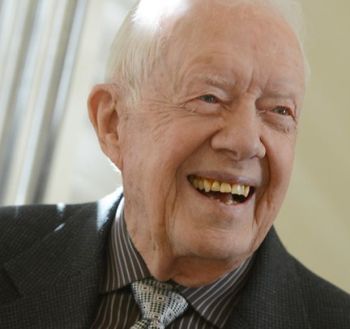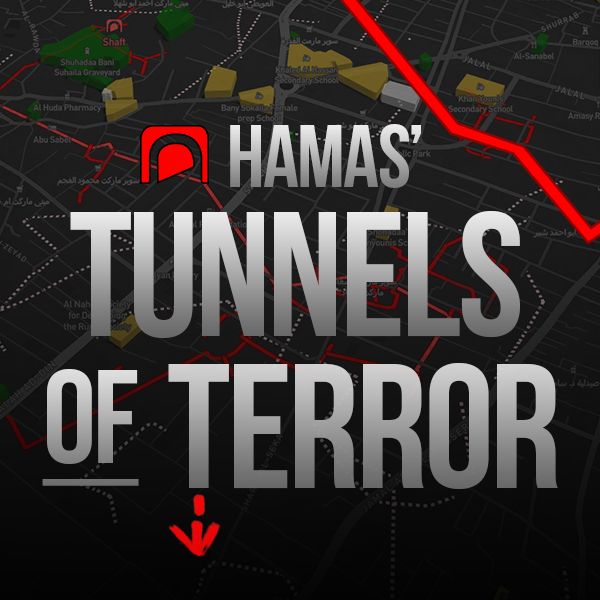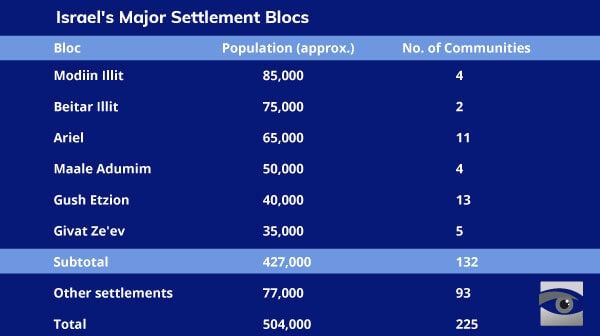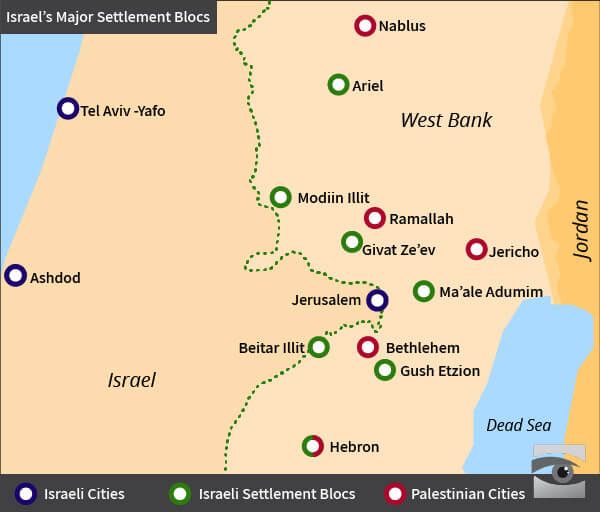The term “settlement blocs” has been used in the Israeli-Palestinian theatre since at least the early 1990s, but came into common use in Middle East peacemaking terminology during the presidency of Bill Clinton.
Join the fight for Israel’s fair coverage in the news
Clinton hoped to nail down a peace treaty by hosting Israeli prime minister Ehud Barak and Palestine Liberation Organization leader Yasser Arafat at Camp David II in 2000. Clinton explained how the blocs fit into his plans for a peace deal:
“… Palestinian sovereignty over Gaza, the vast majority of the West Bank, the incorporation into Israel of settlement blocs, with the goal of maximizing the number of settlers in Israel while minimizing the land annex for Palestine to be viable must be a geographically contiguous state. Now, the land annexed into Israel into settlement blocs should include as few Palestinians as possible, consistent with the logic of two separate homelands. And to make the agreement durable, I think there will have to be some territorial swaps and other arrangements.”
Under the Clinton and similar plans, Israelis living outside the blocs would either be relocated inside the new border, or possibly given the option of staying and living under Palestinian rule.
But what are the blocs?
Semantically, a “bloc” is defined as a combination of persons, groups, or nations forming a unit with a common interest or purpose. In the context of the peace process, the largest Israeli settlement blocs — concentrated clusters of communities — would be retained in any peace process and become part of sovereign Israeli territory. These blocs account for the vast majority of the Jews in the West Bank, with approximately 84% residing in the largest six such blocs.
With many of these blocs situated adjacent to or in close proximity to the Green Line, these are sometimes referred to in Israel as the ‘consensus settlements.’ All final status peace talks between Israelis and Palestinians have envisioned that Israel’s border would be extended to include those settlement blocs. In return, the Palestinians would receive an equivalent area in what is now Israeli territory in what would be a land swap. More on that later.
Where are these settlement blocs, exactly?
Currently, the largest settlement blocs are Gush Etzion and Beitar Illit (both south of Jerusalem), Givat Zeev (north of Jerusalem), Maale Adumim (northeast of Jerusalem), Modiin Illit (central Israel) and Ariel (farther north, near Nablus).
Smaller blocs include Hebron, the South Hebron Hills, the Jordan Valley, Sha’ar Binyamin, and others.
What does ‘consensus’ on the settlement blocs mean?
There is indeed a general consensus that the highly populated blocs of settlements located in areas near the Green Line will remain part of Israel in any peace agreement with the Palestinians. These blocs cover roughly five percent of the West Bank, but contain approximately 80 percent of the entire settlement population.
A look at the Gaza disengagement of 2005 is instructive. One settlement bloc that was dismantled was Gush Katif, where some 8,600 Israelis livingin 17 settlements were evacuated in heart-wrenching scenes. Israeli debate about that withdrawal centered not only the possibility of Hamas taking over the Strip, but whether Israelis would ultimately continue living in the Strip after a final peace deal. Gush Katif didn’t have the wider consensus support that the West Bank blocs have.
That consensus includes not just Israel’s right and left wings, but also the US and even the Palestinians.
The Israeli left has for a long time been part of the consensus. Examples include the Geneva Initiative headed by Yossi Beilin, which comprises many prominent leftists like former Peace Now director Mossi Raz. In 2018 Labor Party MK Eitan Cabel called on his party colleagues to “sober up” and incorporate settlement bloc retention into the Labor platform.
In America the concept of Israel absorbing the settlement blocs also has bipartisan support. In 2009, Secretary of State Condoleeza Rice said that no Israeli leader can accept a peace deal that excludes the large settlement blocs.

Most surprisingly, former President Jimmy Carter, widely perceived as being hostile to any Israeli presence in the West Bank, also expressed his support for Israel’s claim to some of the settlement blocs. Carter visited Gush Etzion in 2009 and told reporters afterwards that it should remain in Israeli hands “forever.”
“This particular settlement area [Gush Etzion] is not one that I envision ever being abandoned or changed over into Palestinian territory,” Carter said. “This is part of the close settlements to the 1967 line that I think will be here forever.”
As for the Palestinians, their official presence at Camp David II and in talks over the years including the peace offer from prime minister Ehud Olmert showed they were party to the idea of Israel’s retention of the settlement blocs. The Palestinians and other Arab leaders have talked openly about the concept.
Future Considerations
The term “settlement bloc” is used because it gives an accurate description that is utilized by all parties involved. The blocs themselves are but one part of the very complex, complicated and convoluted situation between the Israelis and Palestinians.
Although the term “settlement bloc” has no legal standing, it is a flexible and acceptable description used to formulate policies and planning for future contingencies while dealing with the reality on the ground. How peacemaking efforts proceed, of course, remains to be seen.
Jimmy Carter CC0 Georgia Institute of Technology;



